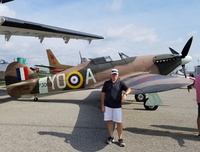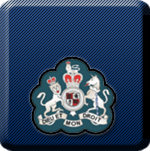Team Fusion (ATAG)
4 posters
Page 1 of 1
 Team Fusion (ATAG)
Team Fusion (ATAG)
hey gents, you may have received this directly but just in case you are not an ATAG member, here it is. Sounds very promising indeed.
Hi virtual pilots!
With the recent announcement that 1C has dropped further development of IL2 Cliffs of Dover, a group of talented programmers and modders called "Team Fusion" have been steadily working on future developments. The 1st internal test version for release candidate 1 is now under full internal testing.
Some of the bug fixes include:
- Flight model correction and the atmospheric engine fixed - This includes historically correct flight models and the high altitude bug being squashed. You will now be able to fly at proper altitudes.
- MP contrails are now visible by every pilot
- Bringing back the original look of weathering and reflections. This also includes the introduction of cockpit glass and cockpit gauge reflections. Depending on sunlight conditions the glass in your cockpit may even have cloud reflections.
- The in-game prop reflections have been greatly improved
- a new device link interface that allows all you virtual pilots with sim pits the ability for device link via IL2 Cliffs of Dover. This has been programmed so ONLY the instruments you have in the particular aircraft you are flying will register with Device link. This has been done to prevent any sort of exploitation of the system
- Numerous bug fixes to various attributes of the aircraft. This includes fixes such as the way fuel delivery works (tank to tank to engine) to incorrect placement of gauges all based on historical accuracy.
- Seasonal map changes of the English Channel map - This includes the standard English Channel Summer map with greatly improved textures, to an Autumn, and Winter versions of the same map
With that said, the 1st patch will focus on what we believe is the most glaring issue of the sim - the flight models. Once we are happy with the accuracy of all aircraft flight models, we will be purging ahead with many other bug fixes and additional content.
The ongoing progress can be seen here: http://theairtacticalassaultgroup.com/forum/forumdisplay.php?93-General-Discussion
Thank you,
Team Fusion
Hi virtual pilots!
With the recent announcement that 1C has dropped further development of IL2 Cliffs of Dover, a group of talented programmers and modders called "Team Fusion" have been steadily working on future developments. The 1st internal test version for release candidate 1 is now under full internal testing.
Some of the bug fixes include:
- Flight model correction and the atmospheric engine fixed - This includes historically correct flight models and the high altitude bug being squashed. You will now be able to fly at proper altitudes.
- MP contrails are now visible by every pilot
- Bringing back the original look of weathering and reflections. This also includes the introduction of cockpit glass and cockpit gauge reflections. Depending on sunlight conditions the glass in your cockpit may even have cloud reflections.
- The in-game prop reflections have been greatly improved
- a new device link interface that allows all you virtual pilots with sim pits the ability for device link via IL2 Cliffs of Dover. This has been programmed so ONLY the instruments you have in the particular aircraft you are flying will register with Device link. This has been done to prevent any sort of exploitation of the system
- Numerous bug fixes to various attributes of the aircraft. This includes fixes such as the way fuel delivery works (tank to tank to engine) to incorrect placement of gauges all based on historical accuracy.
- Seasonal map changes of the English Channel map - This includes the standard English Channel Summer map with greatly improved textures, to an Autumn, and Winter versions of the same map
With that said, the 1st patch will focus on what we believe is the most glaring issue of the sim - the flight models. Once we are happy with the accuracy of all aircraft flight models, we will be purging ahead with many other bug fixes and additional content.
The ongoing progress can be seen here: http://theairtacticalassaultgroup.com/forum/forumdisplay.php?93-General-Discussion
Thank you,
Team Fusion

Speed- Squadron Leader
- Posts : 1967
Join date : 2012-03-15
Age : 69
Location : Kingston Ontario Canada
 Re: Team Fusion (ATAG)
Re: Team Fusion (ATAG)
VERY interesting....
I suggest everyone take a look at this: http://vimeo.com/57880735
In-credible. I'd heard that some folks over there were working on the title, but I wasn't sure what progress could be made. Seems quite a bit.
If you can, I'd recommend throwing a couple of dollars into a donation to ATAG for their efforts and let them know that 401 supports them in what they're doing.
I suggest everyone take a look at this: http://vimeo.com/57880735
In-credible. I'd heard that some folks over there were working on the title, but I wasn't sure what progress could be made. Seems quite a bit.
If you can, I'd recommend throwing a couple of dollars into a donation to ATAG for their efforts and let them know that 401 supports them in what they're doing.
 Re: Team Fusion (ATAG)
Re: Team Fusion (ATAG)
Awesome stuff. My wife is going to kill me when I need new video card.

StiC- Warrant Officer
- Posts : 908
Join date : 2012-02-27
Age : 54
Location : Cape Breton Island
 ATAG Donations
ATAG Donations
I'm making a personal commitment to donate at least once per year just to let them know we support ATAG in more than just spirit.

Speed- Squadron Leader
- Posts : 1967
Join date : 2012-03-15
Age : 69
Location : Kingston Ontario Canada
 Re: Team Fusion (ATAG)
Re: Team Fusion (ATAG)
Here,here.

alpine- Warrant Officer
- Posts : 446
Join date : 2012-02-26
Age : 65
Location : Canada
 Re: Team Fusion (ATAG)
Re: Team Fusion (ATAG)
The progress reports are making me nervous. There seems to be a bias towards the blues. The latest thread shows only 1 RAF aircraft and introduces a 100oc BF109. I'm not familiar with the history so I could be wrong.
UPDATE:
They added some RAF pics and made comments which have addressed most of my concerns. Nothing to see here.
UPDATE:
They added some RAF pics and made comments which have addressed most of my concerns. Nothing to see here.
Last edited by StiC on Mon Feb 04, 2013 7:36 am; edited 1 time in total

StiC- Warrant Officer
- Posts : 908
Join date : 2012-02-27
Age : 54
Location : Cape Breton Island
 History of 100 Octane Fuel
History of 100 Octane Fuel
Cracking of crude petroleum to gasoline
From American Chemical Society website
The first full-scale commercial catalytic cracker for the selective conversion of crude petroleum to gasoline went on stream at the Marcus Hook Refinery in 1937. Pioneered by Eugene Jules Houdry (1892-1962), the catalytic cracking of petroleum revolutionized the industry. The Houdry process conserved natural oil by doubling the amount of gasoline produced by other processes. It also greatly improved the gasoline octane rating, making possible today’s efficient, high-compression automobile engines, During World War II, the high-octane fuel shipped from Houdry plants played a critical role in the Allied victory, The Houdry laboratories in Linwood became the research and development center for this and subsequent Houdry inventions.
The invention and development of gasoline-fueled motor vehicles has had a profound influence on human history providing transport for industrial products and employment for millions and determining where and how we live, work, and play. In the United States today, more than half of the 300 million gallons of gasoline used each day to fuel more than 150 million passenger cars is produced by catalytic-cracking technology. High-octane gasoline paved the way to high compression-ratio engines, higher engine performance, and greater fuel economy.
The most dramatic benefit of the earliest Houdry units was in the production of 100-octane aviation gasoline, just before the outbreak of World War II. The Houdry plants provided a better gasoline for blending with scarce high-octane components, as well as by-products that could be converted by other processes to make more high-octane fractions. The increased performance meant that Allied planes were better than Axis planes by a factor of 15 percent to 30 percent in engine power for take-off and climbing; 25 percent in payload; 10 percent in maximum speed; and 12 percent in operational altitude. In the first six months of 1940, at the time of the Battle of Britain, 1.1 million barrels per month of 100-octane aviation gasoline was shipped to the Allies. Houdry plants produced 90 percent of this catalytically cracked gasoline during the first two years of the war.
From American Chemical Society website
The first full-scale commercial catalytic cracker for the selective conversion of crude petroleum to gasoline went on stream at the Marcus Hook Refinery in 1937. Pioneered by Eugene Jules Houdry (1892-1962), the catalytic cracking of petroleum revolutionized the industry. The Houdry process conserved natural oil by doubling the amount of gasoline produced by other processes. It also greatly improved the gasoline octane rating, making possible today’s efficient, high-compression automobile engines, During World War II, the high-octane fuel shipped from Houdry plants played a critical role in the Allied victory, The Houdry laboratories in Linwood became the research and development center for this and subsequent Houdry inventions.
The invention and development of gasoline-fueled motor vehicles has had a profound influence on human history providing transport for industrial products and employment for millions and determining where and how we live, work, and play. In the United States today, more than half of the 300 million gallons of gasoline used each day to fuel more than 150 million passenger cars is produced by catalytic-cracking technology. High-octane gasoline paved the way to high compression-ratio engines, higher engine performance, and greater fuel economy.
The most dramatic benefit of the earliest Houdry units was in the production of 100-octane aviation gasoline, just before the outbreak of World War II. The Houdry plants provided a better gasoline for blending with scarce high-octane components, as well as by-products that could be converted by other processes to make more high-octane fractions. The increased performance meant that Allied planes were better than Axis planes by a factor of 15 percent to 30 percent in engine power for take-off and climbing; 25 percent in payload; 10 percent in maximum speed; and 12 percent in operational altitude. In the first six months of 1940, at the time of the Battle of Britain, 1.1 million barrels per month of 100-octane aviation gasoline was shipped to the Allies. Houdry plants produced 90 percent of this catalytically cracked gasoline during the first two years of the war.

Speed- Squadron Leader
- Posts : 1967
Join date : 2012-03-15
Age : 69
Location : Kingston Ontario Canada
 Similar topics
Similar topics» Big news regarding Team Fusion
» Team Fusion Patch v4.3 will be released at 6.00pm GMT today March 18th 2014 ;)
» Team Fusion 4.0 Patch Incoming!
» ATAG 3.00 Patch
» Team Fusion 4.31 Hotfix Patch BUGGY
» Team Fusion Patch v4.3 will be released at 6.00pm GMT today March 18th 2014 ;)
» Team Fusion 4.0 Patch Incoming!
» ATAG 3.00 Patch
» Team Fusion 4.31 Hotfix Patch BUGGY
Page 1 of 1
Permissions in this forum:
You cannot reply to topics in this forum